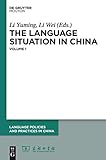The Language Situation in China. Volume 1, 2006–2007 / ed. by Li Wei, Li Yuming.
Material type: TextSeries: Language Policies and Practices in China [LPPC] ; 1Publisher: Berlin ; Boston : De Gruyter Mouton, [2013]Copyright date: ©2013Description: 1 online resource (455 p.)Content type:
TextSeries: Language Policies and Practices in China [LPPC] ; 1Publisher: Berlin ; Boston : De Gruyter Mouton, [2013]Copyright date: ©2013Description: 1 online resource (455 p.)Content type: - 9781614513117
- 9781614512530
- 306.44951
- P119.32.C6.L37 2013
- online - DeGruyter
- Issued also in print.
| Item type | Current library | Call number | URL | Status | Notes | Barcode | |
|---|---|---|---|---|---|---|---|
 eBook
eBook
|
Biblioteca "Angelicum" Pont. Univ. S.Tommaso d'Aquino Nuvola online | online - DeGruyter (Browse shelf(Opens below)) | Online access | Not for loan (Accesso limitato) | Accesso per gli utenti autorizzati / Access for authorized users | (dgr)9781614512530 |
Frontmatter -- Understanding China’s situation through its language life Foreword to The Language Situation in China: English Version Vol. 1 (2006–2007) -- Contents -- Introduction: Building a harmonious language life -- I Language Work -- 1 Language policies and regulations in China: An overview -- 2 The promotion of Putonghua (Mandarin Chinese): An overview -- 3 Evaluation of language management in China’s cities -- 4 Language standardization in China -- 5 Language resource monitoring and applied research on language -- 6 The status of the language in the press and publishing -- 7 Use of language in radio and television broadcasting -- 8 Standardization of scientific terms in China -- 9 Ethnic minority bilingual education in China -- 10 The standardization and computerization of minority languages and writing -- 11 Cross-provincial cooperation in enhancing the development of the spoken and written languages of the ethnic minorities in China -- II Special Research -- 12 Status quo of language use in medical documents and on medicinal packages -- 13 The Language status of migrant workers -- 14 Efforts of creating a good language environment for Běijīnɡ Olympic Games: A brief report -- 15 A survey of Shànɡhǎi students’ use of Putonghua and Shànɡhǎi dialect -- 16 Status quo of the Jinuo language -- 17 A survey of Chinese characters, words and phrases used in news media (2005–2006) -- 18 Investigation of Tibetan language informationization and software use -- 19 An investigation into lettered words -- III Language Focuses -- 20 Dialect craze -- 21 Controversy in Chinese language education: Classical or vernacular? -- 22 Language endangerment -- 23 The craze for English -- 24 The use of characters for names -- 25 Chinese buzzwords (2002–2006) -- 26 A survey of media neologisms in 2006 -- IV Hong Kong, Macau and Taiwan -- 27 Putonghua in Hong Kong -- 28 Language and language policy in Hong Kong -- 29 Language situation and language policy in Macao -- 30 The Linguistic situation and language policy in Taiwan -- 31 Internet language use -- Appendixes -- Appendix 1: Order of the President of the People’s Republic of China No. 33 -- Appendix 2: List of Standards for Language and Writing Planning -- Appendix 3: List of Languages in China -- Appendix 4: List of Institutions for Chinese Linguistics and Applied Linguistics -- Appendix 5: Directories of Language Journals and Newspapers -- Appendix 6: Distribution of Chinese Population Worldwide -- A Record of Major Chinese Language Events (2005) -- A Record of Major Chinese Language Events (2006) -- Contents (Chinese version 2005 Volume I) -- Contents (Chinese version 2006 Volume I) -- Postscript -- List of authors of the original Chinese text -- Editorial Teams of the English Edition -- Index
restricted access online access with authorization star
http://purl.org/coar/access_right/c_16ec
China, with the world's largest population, numerous ethnic groups and vast geographical space, is also rich in languages. Since 2006, China's State Language Commission has been publishing annual reports on what is called "language life" in China. These reports cover language policy and planning invitatives at the national, provincial and local levels, new trends in language use in a variety of social domains, and major events concerning languages in mainland China, Hong Kong, Macau and Taiwan. Now for the first time, these reports are available in English for anyone interested in Chinese language and linguistics, China's languge, education and social policies, as well as everyday language use among the ordinary people in China. The invaluable data contained in these reports provide an essential reference to researchers, professionals, policy makers, and China watchers.
Issued also in print.
Mode of access: Internet via World Wide Web.
In English.
Description based on online resource; title from PDF title page (publisher's Web site, viewed 25. Jun 2024)


